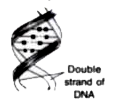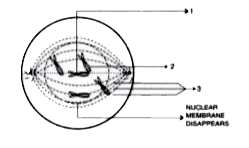List the main differences between mitosis and meiosis
Step-by-Step Solution
1. Definition of Mitosis and Meiosis:
- Mitosis is a type of cell division that occurs in somatic (body) cells, resulting in two identical daughter cells.
- Meiosis is a specialized type of cell division that occurs in germ (reproductive) cells, resulting in four genetically diverse daughter cells.
2. Number of Divisions:
- In mitosis, the nucleus divides only once.
- In meiosis, the nucleus divides twice.
3. Number of Daughter Cells:
- Mitosis produces two daughter cells.
- Meiosis produces four daughter cells.
4. Chromosome Number in Daughter Cells:
- The daughter cells produced by mitosis are diploid (2n), meaning they have two sets of chromosomes.
- The daughter cells produced by meiosis are haploid (n), meaning they have one set of chromosomes.
5. Function of Daughter Cells:
- The daughter cells formed through mitosis are used for growth, repair, and maintenance of somatic tissues.
- The daughter cells formed through meiosis are gametes (sperm and eggs), which are involved in sexual reproduction.
6. Frequency of Division:
- Mitosis occurs more frequently in the body for growth and repair.
- Meiosis occurs less frequently, primarily during the formation of gametes.
7. Type of Division:
- Mitosis is referred to as an equational division because the chromosome number remains the same.
- Meiosis is referred to as a reductional division because it reduces the chromosome number by half.
Summary of Differences
| Feature | Mitosis | Meiosis |
|-------------------------------|---------------------------------|----------------------------------|
| Type of Cells | Somatic cells | Germ cells |
| Number of Divisions | One | Two |
| Number of Daughter Cells | Two | Four |
| Chromosome Number | Diploid (2n) | Haploid (n) |
| Function | Growth and repair | Formation of gametes |
| Frequency of Division | More frequent | Less frequent |
| Type of Division | Equational division | Reductional division |
- Mitosis is a type of cell division that occurs in somatic (body) cells, resulting in two identical daughter cells.
- Meiosis is a specialized type of cell division that occurs in germ (reproductive) cells, resulting in four genetically diverse daughter cells.
- In mitosis, the nucleus divides only once.
- In meiosis, the nucleus divides twice.
- Mitosis produces two daughter cells.
- Meiosis produces four daughter cells.
- The daughter cells produced by mitosis are diploid (2n), meaning they have two sets of chromosomes.
- The daughter cells produced by meiosis are haploid (n), meaning they have one set of chromosomes.
- The daughter cells formed through mitosis are used for growth, repair, and maintenance of somatic tissues.
- The daughter cells formed through meiosis are gametes (sperm and eggs), which are involved in sexual reproduction.
- Mitosis occurs more frequently in the body for growth and repair.
- Meiosis occurs less frequently, primarily during the formation of gametes.
- Mitosis is referred to as an equational division because the chromosome number remains the same.
- Meiosis is referred to as a reductional division because it reduces the chromosome number by half.
|-------------------------------|---------------------------------|----------------------------------|
| Type of Cells | Somatic cells | Germ cells |
| Number of Divisions | One | Two |
| Number of Daughter Cells | Two | Four |
| Chromosome Number | Diploid (2n) | Haploid (n) |
| Function | Growth and repair | Formation of gametes |
| Frequency of Division | More frequent | Less frequent |
| Type of Division | Equational division | Reductional division |
Topper's Solved these Questions
- CELL CYCLE AND CELL DIVISION BOOK - ICSECHAPTER - CELL CYCLE AND CELL DIVISION EXERCISE - NCERT EXERCISE WITH ANSWER (DIFFERENT BETWEEN )
4 Videos
- CELL CYCLE AND CELL DIVISION BOOK - ICSECHAPTER - CELL CYCLE AND CELL DIVISION EXERCISE - REVIEW QUESTIONS (MULTIPLE CHOICE QUESTIONS) (CHOOSE THE CORRECT ANSWER):
53 Videos
- CELL CYCLE AND CELL DIVISION BOOK - ICSECHAPTER - CELL CYCLE AND CELL DIVISION EXERCISE - TEST YOUR PROGRESS (HIGHER ORDER THINKING SKILLS QUESTIONS (HOTS))
8 Videos
- CELL : THE UNIT OF LIFE BOOK - ICSECHAPTER - CELL : THE UNIT OF LIFE EXERCISE - Differentiate Between
18 Videos
- CELLULAR RESPIRATION IN PLANTS BOOK - ICSECHAPTER - CELLULAR RESPIRATION IN PLANTS EXERCISE - REVIEW QUESTIONS ( LONG ANSWER TYPE QUESTIONS)
15 Videos
Similar Questions
Mitosis and meiosis II
View SolutionDifference Between Mitosis And Meiosis
View SolutionDifferentiate between :
Mitosis and Meiosis
View SolutionGiven below is a diagram of a double helical structure of DNA.

Mention two points of difference between Mitosis and Meiosis.
View SolutionGiven below is a diagram representing a stage during mitotic cell division in an animal cell:

Mention two points of difference between 'mitosis' and 'meiosis' with regard to :
The number of daughter cells formed.
The chromosome number in the daughter cells.
View SolutionWhat is the main difference between position isomerism and functional isomerism? Explain with an example.
View SolutionWhat is the main difference between male and female cockroach ?
View SolutionWhat is the main difference between sperms and eggs of humans ? Write the importance of this difference.
View SolutionWhat is the main difference between London smog and Los Angeles smog ?
View SolutionGive short answers :
What is the main difference between alchemy and chemistry?
View Solution
